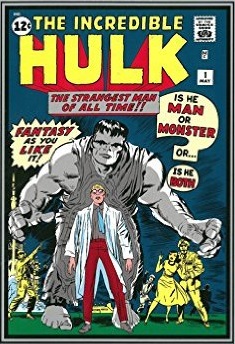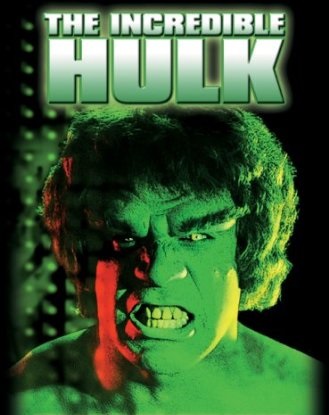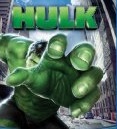The Incredible Hulk character, first created by comics master Stan Lee in the early 1960s, has become one of the iconic figures of our age. Here I will look at the differences among the Hulk personae and storylines in the various treatments it has received, from its inception to the recent past.
When Stan Lee first conceived of the Hulk, Marvel comics was going through a period of transition. The company was experiencing sagging sales and needed fresh ideas to boost circulation. The Hulk was meant to be a different kind of superhero; the inspiration for the character came from the classic horror tales "Frankenstein" and "Dr. Jekyll and Mr. Hyde". Could the creative team of Stan Lee and Jack Kirby make a hero out of a monster?
The Incredible Hulk was introduced to the world in May 1962. The Hulk was originally colored gray, but problems with consistency of appearance from panel to panel in advance copies of the debut edition compelled Lee to have the monster re-inked in a different color. He chose green, and a legend was born.
In the comic series, scientist Bruce Banner developed his uncontrollable powers when he was exposed to gamma radiation during a test blast he was conducting for the U.S. government. The accident occurred because of the treacherous actions of a Russian spy. Unlike later incarnations of the character, Banner did not transform because of emotional stress. He simply turned into the Hulk at night, becoming human again at the break of dawn.
Still, he became a rampaging brute, pursued by the military, just holding on to his humanity as he struggled to overcome his bizarre predicament. His tragic dual nature made him an endearing protagonist, despite all the gratuitous property damage. In subsequent issues, the Hulk was drawn in much higher quality, and began to resemble a green Hercules. He joined Marvel's pantheon of heroic figures, his series continuing into the 1990s.
Eventually, the Incredible Hulk was adapted for a TV series that aired on CBS in the late 1970s and early 1980s. But some significant changes occurred to the character and story which reflected the new priorities of a society that had just experienced a turbulent cultural transformation.
The scientist David Banner, portrayed by Bill Bixby, became the Hulk after an experiment gone awry, just as his predecessor Bruce Banner had. However, in the TV series, the experiment was Banner's own personal project in biology, not a government sponsored weapons test. And Banner's first transformation occurred when he became angry after inadvertently injuring himself. It was not merely science gone awry that caused the Hulk to emerge, but the emotional core of Banner's humanity.
The TV Hulk was not pursued by squads of soldiers, but rather by a nosy reporter following the case of the mysterious disappearance of Dr. Banner. David Banner himself became a drifter, wandering from town to town on his quest to understand himself, famously ending each episode hitchhiking on a lonely road, with a haunting theme song playing in the background.
And so the Hulk, at first an unfortunate suffering from the vagaries of institutionalized military power, became an individual at war with his own nature. Dr. Banner, once a square, bespectacled government scientist, became a hip roadster in search of salvation. The story had been adapted to the self-absorbed mores that had become dominant in the wake of the cultural revolution of the 1960s and 1970s.
Several television movies spun off from the CBS series, but the Incredible Hulk finally made it to the big screen in Ang Lee's 2003 adaptation "Hulk". The new Lee took elements from both the comic and TV stories, and then added some twists of his own. Bodybuilder Lou Ferrigno portrayed the transformed Banner in the TV show, but in this 21st century version the monster was made of pure CGI.
Another 21st century update to the story was the introduction of nanotechnology as part of the rationalization for how the Hulk powers manifest. And there was more - the nanotechnology combined with Bruce Banner's genes inherited from his father, David Banner, who had genetically modified himself while working as a scientist at a desert military base during the 1960s. So this reinterpretation was like a passing of the story from one generation to the next.
Built into that story was all the psychodrama of the troubled upbringing of the post-Awakening generation. The young Banner witnessed family turmoil, and was separated from his parents as a boy. As a young man he experienced broken relationships and repressed emotion. His transformative experience was not a quest of self-discovery, but a battle with personal demons.
Ang Lee's "Hulk" movie was not well received, reflecting perhaps its unseasonal nature. It told a tale of personal angst to a society ready to move on. The 2008 version, "The Incredible Hulk", may be more what the public yearns for - a return to the epic sweep of heroic adventure and the archetypal battle of good against evil.
 |
|
Year: 1962- Writer: Stan Lee (GI Generation, born 1922) Artist: Jack Kirby (GI Generation, born 1917) |
 |
|
Year: 1978-1982 Starring: Bill Bixby (Silent Generation, born 1934), Lou Ferrigno (Boomer Generation, born 1951) |
 |
|
Year: 2003 Director: Ang Lee (Boomer Generation, born 1954) Starring: Eric Bana (Generation X, born 1968) |